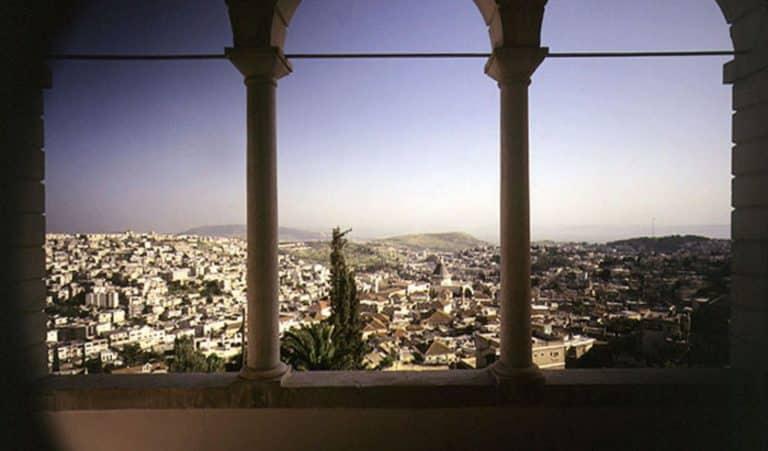May has already begun, and this month invites us to gather around Our Lady. There are many ways to do so, and one of them is to go directly to the place where Mary lived her daily life: Nazareth. Here the Virgin conceived Jesus, beginning the story of redemption; here the Holy Family lived together for thirty years, according to the Gospel narrative.
The city of Nazareth
Nazareth is today a small town located in the hills of northern Israel. It has less than 80,000 inhabitants, and yet, in this small size, Nazareth experiences an interreligious coexistence that hardly has parallels anywhere else. Here, Christians, Muslims, and Jews live close contact, without Nazareth ever having been at the centre of any major clashes.
Nazareth’s role could be said to be half-hidden, on the margins of the new. Something that has distinguished the town throughout its history. The earliest available finds from the area indicate that Nazareth was inhabited in the late Bronze Age, although we have no written record of it.
Roman Nazareth
With the Roman conquest of the province of Palestine, in 63 B.C., the area above which Nazareth stood experienced a new vitality, thanks to the commercial activity of the neighbouring Sepphoris The famous Via Maris, the “street of the sea”, possibly walked by Jesus on his way to Judea, passed by Nazareth and Sepphoris, bringing trade and wealth to these centres.
But Nazareth had to remain rather humble in its conformation. According to the Evangelist John, Nathanael is well known for his astonished reaction to Philip’s announcement of the new Messiah from Nazareth: “Is it possible for any good to come out of Nazareth?” (John 1, 46). Another sign, if there were still need, of the Lord’s predilection for the outskirts of the world.
Nazareth experienced a tragic chapter in its history during the Jewish wars. When, after the destruction of the Temple of Jerusalem in 70 A.D., the Jewish people tried to rebel against the power of Rome under the leadership of Simon Bar Kochba, Galilee became one of the centres of revolts. As a result, during the Second Jewish War, in the middle of the 2nd century AD, Emperor Hadrian’s troops destroyed the city of Nazareth, believing it to be a refuge for the insurgents.
Fall and rebirth
But in Nazareth, stronger than arms, peace was already singing. It is surely here that one of the first forms of coexistence between traditional Judaism and its new offspring, Christianity, found its home. Archaeology bears witness to this. As early as Byzantine times, there were Christian places of worship in the city, including a church on the same site as the present one. And then some historians such as Hegesippus and Eusebius of Caesarea, both close to proto-Christian circles, report the pride that some people took in Nazareth, of belonging to the family of Jesus. And it is of this proximity to the house of the Lord that the anonymous pilgrim from Piacenza, in the middle of the 6th century, speaks to us again. In his diaries, he states that he found beautiful women in the city, who indicated that their beauty was due to their blood relationship with the Virgin Mary.
Nazareth went peacefully through the period of Persian occupation. . It also resisted the invasion of Arabs, who tried to destroy the city on several occasions, until the arrival of the Crusaders in 1099, when Nazareth was able to flourish again. A new, large monumental Church – 70 metres long by 30 metre high – could finally rise in place of the previous Byzantine church.
Franciscan Nazareth
A tenuous, everyday light, that which illuminates Nazareth, was dimmed when, on 4 July 1187, while Saladin was triumphing over the crusaders near Hattin, some troops of the Islamic leader carried out a massacre of Christians in the perimeter of the city. Inter-religious coexistence in the city seemed to die out when, in 1263, Sultan Baibars set fire to the Crusader church and razed it to the ground.
All traces of Christian Nazareth were lost until the 17th century, when the Franciscan friars managed, through a series of ups and downs, to regain possession of the ruins of the destroyed church. So it started again a daily coexistence process among the faiths that brought to the establishment of peace in the city once again. The same peace witnessed in the life of the future saint Charles de Foucauld, who lived part of his vocation to the consecrated life here.
Our days
During the 1948 war, Nazareth entered the war chronicles in the first conflict between Arabs and Israelis. On 15 July, an Israeli plane bombed the Arab village of Sepphoris and caused panic among the population; many villagers fled north to Lebanon, others found refuge in Nazareth, leaving about 100 elderly people behind. On the evening of 16 July, Nazareth surrendered to the Israelis after a light fight that left one Israeli dead and one wounded. An attitude that allowed the Arab population of the city to keep possession of their homes and possessions.
A silent womb, that of Nazareth, which today makes room for dialogue and peace. Fragile goods, it is true, even in this land, where difficult pages have been recorded (the last one with the clashes of spring 2021). But fundamental goods, which do not cease, day after day, to radiate from Nazareth and from the Nazarene to the whole world.












